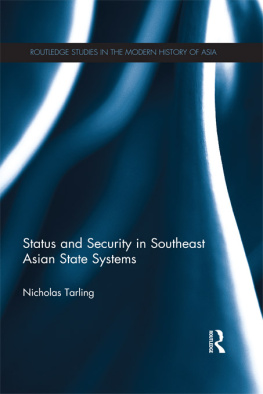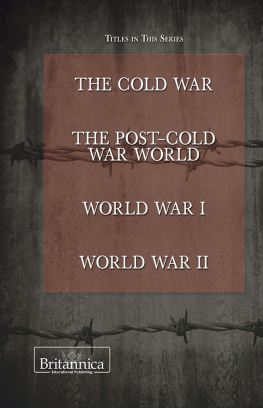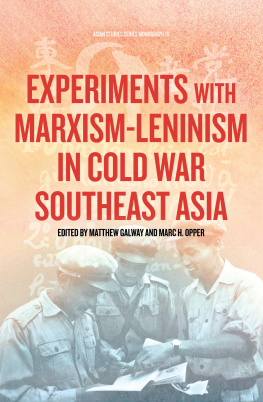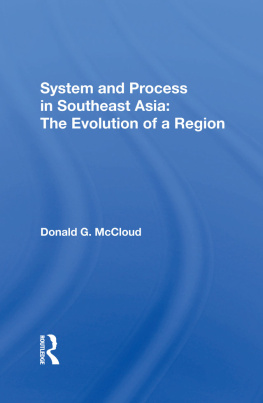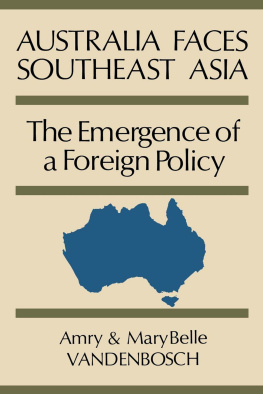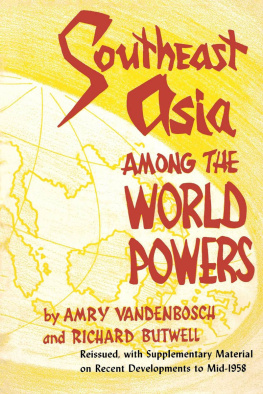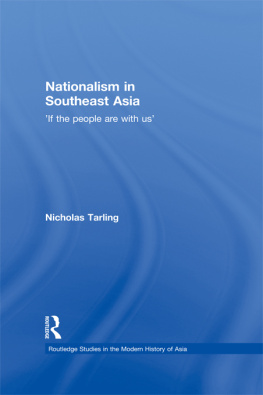COLD WAR SOUTHEAST ASIA
For Nicolas
Copyright 2012 Marshall Cavendish International (Asia) Pte Ltd
Published in 2012 by Marshall Cavendish Editions
An imprint of Marshall Cavendish International
1 New Industrial Road, Singapore 536196
All rights reserved
No part of this publication may be reproduced, stored in a retrieval system or transmitted, in any form or by any means, electronic, mechanical, photocopying, recording or otherwise, without the prior permission of the copyright owner. Request for permission should be addressed to the Publisher, Marshall Cavendish International (Asia) Pte Ltd, 1 New Industrial Road, Singapore 536196.
Tel: (65) 6213 9300, fax: (65) 6285 4871. E-mail:
The publisher makes no representation or warranties with respect to the contents of this book, and specifically disclaims any implied warranties or merchantability or fitness for any particular purpose, and shall in no events be liable for any loss of profit or any other commercial damage, including but not limited to special, incidental, consequential, or other damages.
Other Marshall Cavendish Offices:
Marshall Cavendish Ltd. PO Box 65829, London EC1P 1NY, UK Marshall Cavendish Corporation. 99 White Plains Road, Tarrytown NY 10591-9001, USA Marshall Cavendish International (Thailand) Co Ltd. 253 Asoke, 12th Flr, Sukhumvit 21 Road, Klongtoey Nua, Wattana, Bangkok 10110, Thailand Marshall Cavendish (Malaysia) Sdn Bhd, Times Subang, Lot 46, Subang Hi-Tech Industrial Park, Batu Tiga, 40000 Shah Alam, Selangor Darul Ehsan, Malaysia
Marshall Cavendish is a trademark of Times Publishing Limited
National Library Board Singapore Cataloguing-in-Publication Data:
Cold War Southeast Asia / edited by Malcom H. Murfett. Singapore :
Marshall Cavendish Editions, c2012.
p. cm.
Includes bibliographical references and index.
eISBN : 978-981-4382-98-4 (pbk.)
1. Cold War Political aspects Southeast Asia. 2. Southeast Asia Politics and government 1945- I. Murfett, Malcolm H.
DS526.7
959.053 dc23 OCN781340443
Cover photograph: LBJ Library, photo by Yoichi Okamoto
Printed in Singapore by Fabulous Printers
CONTENTS |
Malcolm H. Murfett |
Ang Cheng Guan |
Cheah Boon Kheng |
Ricardo T. Jose |
Brian P. Farrell |
Tan Tai Yong |
Sutayut Osornprasop |
Bruce Lockhart |
Brian M. Linn |
Malcolm H. Murfett |
Dewi Fortuna Anwar |
The Cold War in hindsight:
local realities and the limits of global power |
Merle C. Ricklefs |
PREFACE
This volume of essays on the Cold War in Southeast Asia grew out of a series of very popular public lectures held on a monthly basis at the National Library in Singapore from September 2008 to May 2009. Enthusiastically supported by the Asia Research Institute, the Department of History at the National University of Singapore, and the History Channel, the evening lectures downtown played to full houses drawn from a wide cross-section of the general public.
Public lectures are a wonderful way of giving back to the community. It was heart-warming to see packed lecture rooms and a lively audience that really participated in the Q&A sessions following the lectures. I hope there will be more such initiatives in the future.
Once we had completed the nine lectures, I began to think of supplementing the original contributions with a number of invitations to scholars who could shed light on the political situation in those states that we hadnt had the opportunity of covering in the original series. Their contributions have helped to provide additional insights into the wider region in the years after the end of World War II when the spectre of communism was stalking the stage.
As always, acknowledging the help of others in the preparation of a book is both fitting and appropriate. My fellow authors and I have benefited greatly from the knowledge and wisdom offered to us by a group of talented librarians and archivists in research centres dotted around the world. We are especially indebted to the following institutions for their records, without which this book would never have seen the light of day: Air Force Historical Research Agency (US), Maxwell Air Force Base, Alabama; Archives New Zealand, Wellington; Australian War Memorial, Canberra; Commonwealth Relations Office, London; Dwight D. Eisenhower Presidential Library and Museum, Abilene, Kansas; Filipinas Heritage Library, Makati; National Archives of Australia, Canberra; The National Archives of the UK, Kew Gardens, London; SAFTI Military Institute Library, Singapore; University of the Philippines Archives, Manila; US Army Combined Arms Center, Fort Leavenworth, Kansas; US Army Military History Institute, Carlisle, Pennsylvania; US National Archives, Washington, D.C.
All copyright material drawn from both public records and private collections is reproduced by permission of the relevant authorities identified in the notes.
In addition, Ang Cheng Guan wishes to thank the publisher of Kajian Malaysia for permission to quote from his article, Vietnam in 1948: An International History Perspective, which appeared in the journal in 2009 (vol. 27, nos 1 and 2, pp. 6184).
Once again, I am indebted to Melvin Neo, the managing editor of Marshall Cavendish International (Asia), and to Justin Lau, our publishing editor, both of whom it has been a privilege to work with on this latest project of ours.
Im also very happy to acknowledge the painstaking work of Stephanie Williams, who compiled the index with considerable distinction and admirable speed.
A final word of gratitude must go to the Lee Foundation in Singapore, which has consistently supported the editor in his research activities over more years than he cares to think about!
Malcolm H. Murfett
Singapore
25 January 2012
INTRODUCTION
Agreement on who or what caused the Cold War remains elusivesmoking guns do exist but there are rather too many of them for us to make much sense of who really pulled the trigger and brought this geopolitical reality about in the first instance. All that can be safely agreed upon is that a deep hostility between the communist and democratic states of the world had become a grim fact of life for millions of people in the years after the ending of the Second World War.
Victory in war for the Grand Alliance had come at an enormous price. Once Hitlers Nazi state had been eclipsed in Europe in May 1945 and Imperial Japan had been bombed into seeking an immediate armistice in mid-August, the rationale for the original formation of the Grand Alliance no longer applied and the tri-national grouping of the UK, US, and USSR swiftly fell apart. While the British, beset by financial and economic problems, swiftly subsided into the ranks of the also-rans, the Americans and the Soviets emerged as the two superpowers intent on leading their ideological allies and client states into the post-war period. Having won the war neither had any intention of losing the peace thereafter.


